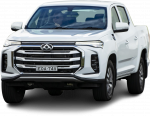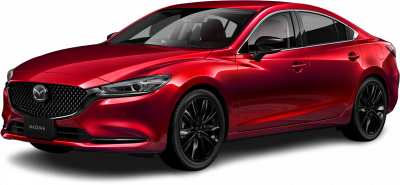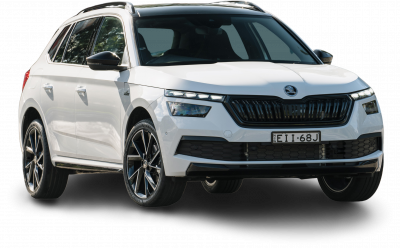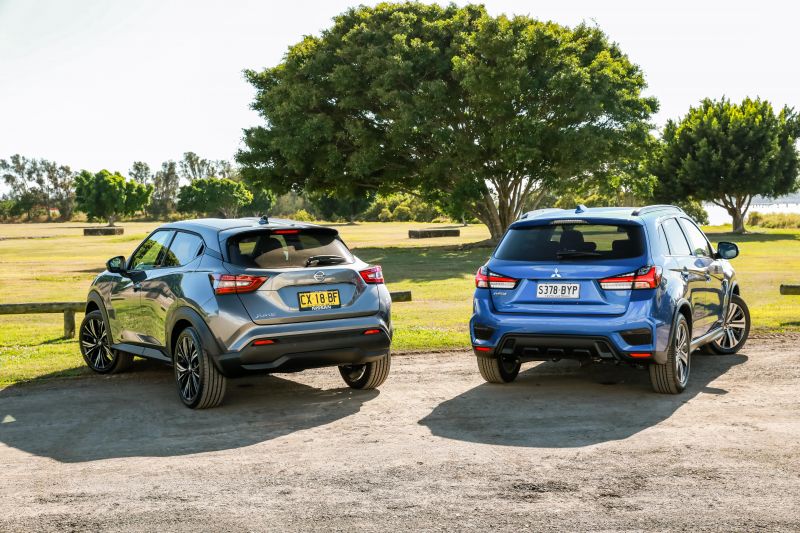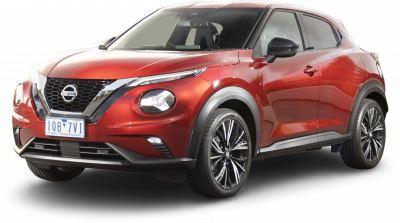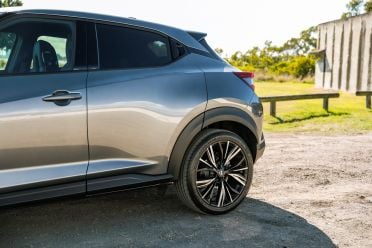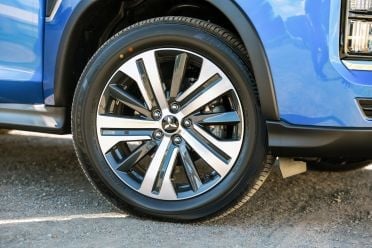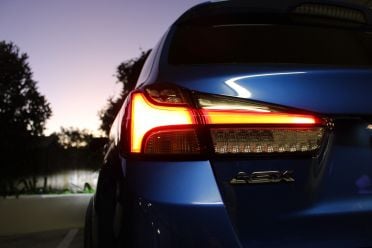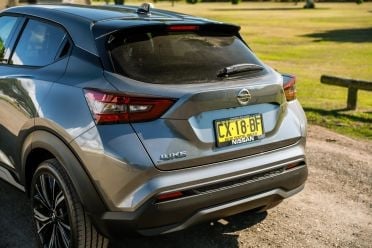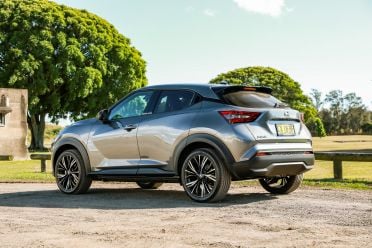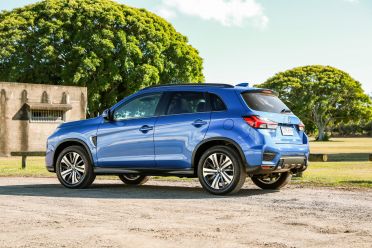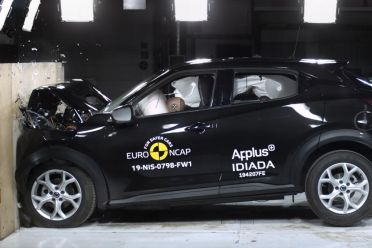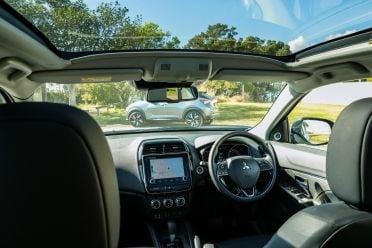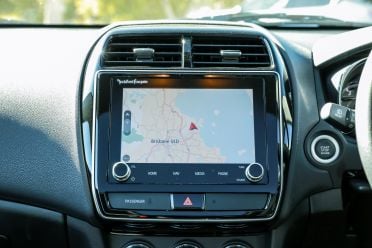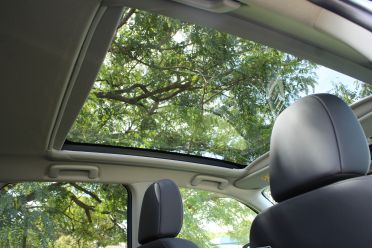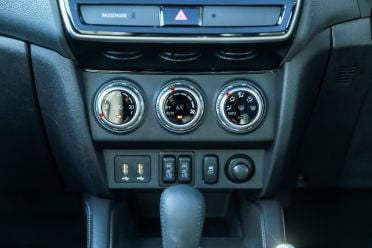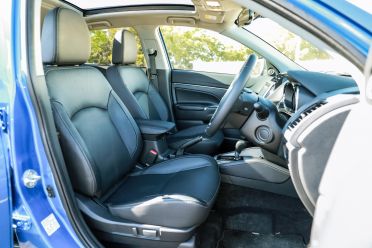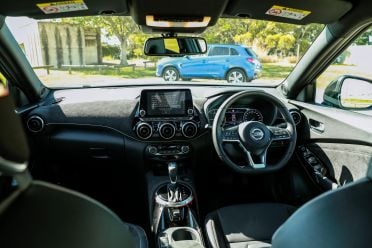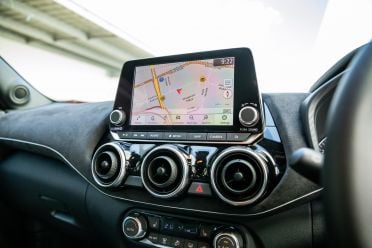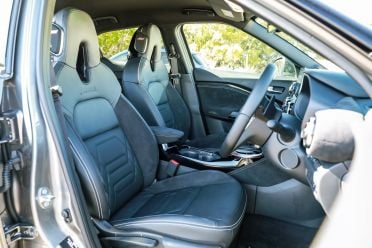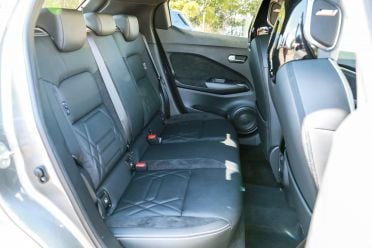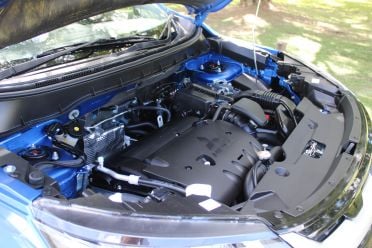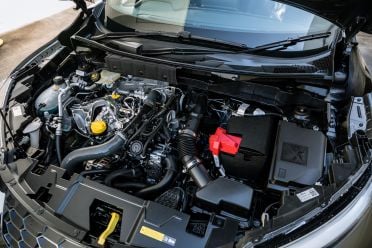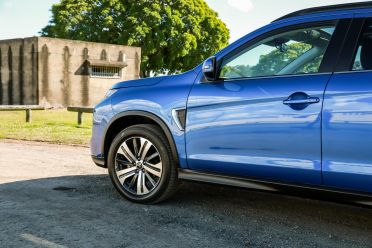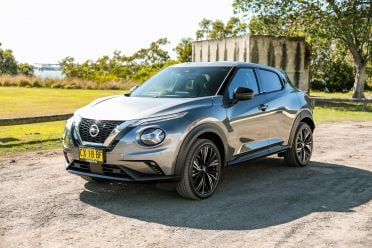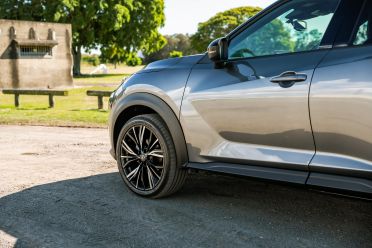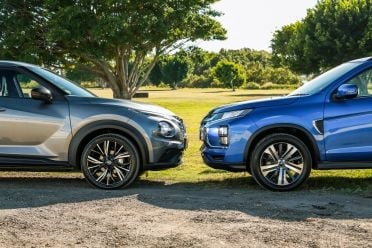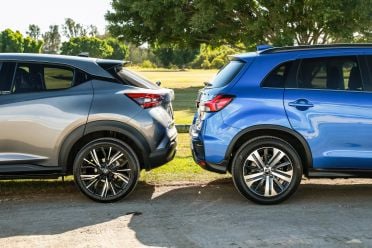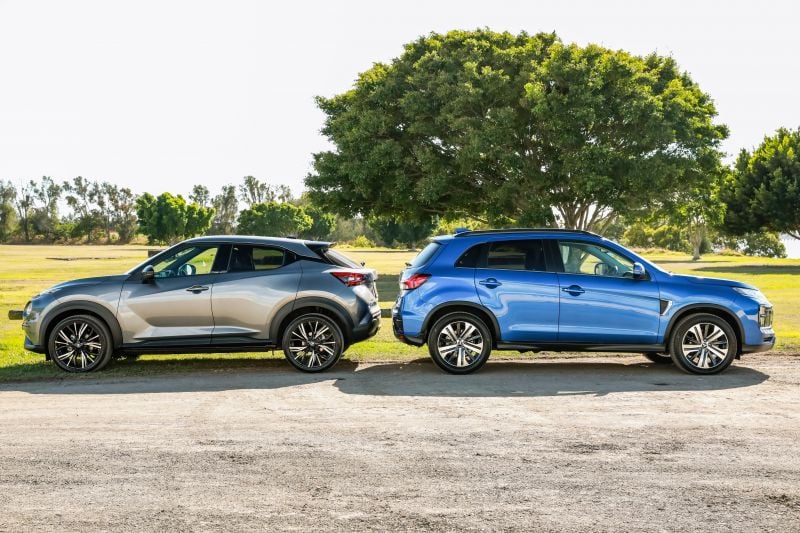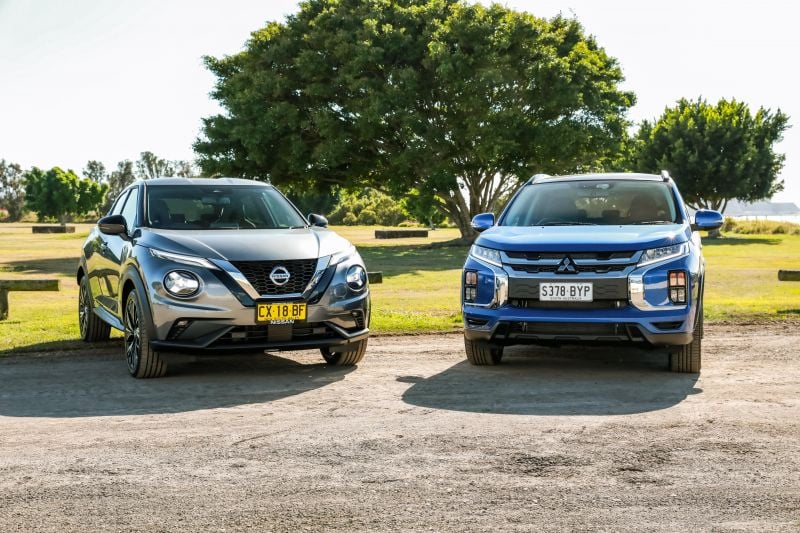You might see the title of this comparison and think, “Hold up, isn’t the ASX more of a Nissan Qashqai rival?”
After all, the ASX and Qashqai are both ‘Small SUVs’ according to industry reporting body VFACTS, while the Juke sits in the ‘Light SUV’ segment created this year.
The splitting of the segment was largely a response to the increasing number of SUVs smaller than your typical Mitsubishi ASX, some of which – like the second-generation Juke here, or the new Ford Puma – are pitched less as practical alternatives to passenger cars and instead more as style-focused high-riding runabouts.
But the distinction is largely academic. Buyers of vehicles like this often know they want an SUV and make decisions based on price points. In that respect, the ASX and Juke may both appear on many shortlists.
They’re roughly the same price but one is a style queen and the other is made in the more traditional crossover SUV mould. Which works better for you?
Compare the cars
Unpack the key differences in performance, features, and value.

ASX
How much?
We’ve compared the range-topping trim levels of each model line.
Though the Juke is the smaller and less powerful of this pair, its top-spec Ti is priced at $36,490 before on-road costs.
The ASX Exceed is priced at $33,490 before on-road costs, though Mitsubishi is currently offering it for $35,990 drive-away with a seven-year, unlimited kilometre warranty.
What do you get?
With the ASX, you get a bigger car. Measuring 4365mm long, 1640mm tall and 1810mm wide, the ASX is 155mm longer, 45mm taller, and 10mm wider than the Juke.
If you value uniqueness, however, the Mitsubishi falls short. It seems like there’s an ASX on virtually every street in Australia, with sales actually growing every year since its launch back in 2010 except one. To the end of last year, Mitsubishi had sold 124,097 examples locally.
Last year’s facelift spruced up the styling and – in my eyes at least – the ASX’s exterior looks better than it ever has before, with a more resolved chrome ‘dynamic shield’ grille and attractive LED lighting.
But then there’s the Juke which, compared to its predecessor, is more bulldog than bullfrog with a squat stance and more mature detailing.
Both the Juke Ti and ASX Exceed feature an 8.0-inch touchscreen infotainment system with Android Auto, Apple CarPlay and satellite navigation, as well as leather seats that are heated up front, automatic LED headlights, rain-sensing wipers, and proximity entry with push-button start.
The ASX has a nine-speaker Rockford Fosgate sound system while the Juke has an eight-speaker Bose setup, with two of those speakers mounted in the front headrests. The ASX has DAB digital radio while the Juke has DAB+.
A point for the Nissan for adding front parking sensors and a 360-degree camera, both of which make parking a doddle. The Alcantara-heavy interior and illuminated sill plates add a premium touch.
The ASX’s huge fixed glass roof is wonderful. We also appreciate the ASX’s power driver’s seat. Still, the Juke has the overall edge in terms of standard equipment.
Are they safe?
Both the ASX and the Juke sport a five-star rating from ANCAP, though the Juke has a newer date stamp of 2019 while the ASX was tested back in 2014.
That also means the ASX was tested under older protocols and therefore doesn’t have overall scores for Adult Occupant Protection, Child Occupant Protection, Vulnerable Road User Protection and Safety Assist. In these categories, the Juke scored 94, 87, 81 and 71 per cent, respectively.
In the older testing regimen, ASX scored 14.13 out of 16 in the frontal offset test and received Good and Acceptable ratings for pedestrian and whiplash protection, respectively. You can view the full technical report for the ASX here and the Juke report here.
Both models come standard with blind-spot monitoring, lane-departure warning, rear cross-traffic alert, outboard Isofix and top-tether anchor points for child seats, and front, front-side and curtain airbags, and the ASX adds a driver’s knee airbag.
The Juke has an edge with traffic sign recognition as well as Nissan’s ‘intelligent-lane intervention’ – lane-departure warning that activates braking if you stray out of your lane. It also has adaptive cruise control instead of the ASX’s regular cruise control, as well as a digital speedometer.
The ASX’s autonomous emergency braking system – Forward Collision Mitigation in Mitsubishi parlance – works at speeds of between 5 and 80km/h if it detects a vehicle and 5 and 65km/h with pedestrians.
The Juke’s system (Intelligent Emergency Braking) adds cyclist detection, though the braking function will only work at speeds of up to 60km/h despite the detection working at speeds of up to 80km/h.
What are they like inside?
Mitsubishi
The ASX’s interior has aged fairly well over its decade-long life. There was a slight reshaping of the centre stack a few years ago to accommodate a larger 8.0-inch touchscreen, while the centre console was squared off a little bit. Otherwise, it looks much the same as ever.
Its advanced age means it’s missing some things that have become commonplace, from an electric parking brake to a digital speedometer. Its trip computer is also daft, controlled only via a single button.
It does some things right, however. There are soft-touch plastics across the dashboard and the tops of the front doors, for example, plus leatherette on the side of the centre console, while the fixed glass roof is squeak-free and lets in a glorious amount of natural light.
You sit up higher in the ASX, with the traditional command seating position of an SUV.
The infotainment system has dated graphics, particularly the satellite navigation which defaults to an annoyingly zoomed-out view. It also has strange quirks like displaying the state at the end of every suburb name, even if you’re nowhere near a border.
Fortunately, there’s Apple CarPlay and Android Auto to use, while the Rockford Fosgate sound system has sound quality almost as good as the more familiarly named Bose unit in the Juke.
Fortunately, the ASX Exceed has far fewer button blanks than an Outlander Exceed – we counted just two.
While the interior is mostly well screwed together, there are some aspects that make the ASX feel old and cheap.
For example, the doors feel light and shut with a hollow sound. There are also the thin ‘modesty covers’ used on the front and rear seat backs that look like offcuts hastily stuck on. And the front seats feel flat and lacking in padding.
There’s plenty of legroom for an 180cm tall passenger sitting behind a front seat occupant of the same height. Headroom is another matter – at 180cm, my head was brushing the ceiling if I sat up properly. While rear seat occupants enjoy the fixed glass roof, there are precious few amenities – no air-conditioning vents and no USB ports.
Nissan
The ASX’s functional yet dated interior is shaded by the Juke’s, at least in terms of presentation.
The application of ambient lighting and swathes of Alcantara trim across the dash and seats lends the Juke an upscale vibe, while soft-touch plastics are also used for the dashboard.
The interior feels a little darker and more confining than the ASX’s, probably due to the lower roof line, higher belt line and the lack of a sunroof. The vibe, however, is sportier – you sit in the front seats, not on them, and they’re much more supportive than the ASX’s and offer thicker bolstering.
The infotainment system looks several generations newer than that of the ASX but it’s not perfect – some streets didn’t appear on the map when we used it, the steering wheel voice command button doesn’t allow you to dictate navigation instructions, and the overall layout is a bit cluttered.
The Bose sound system is a banger and we love the placement of two of the speakers in the front headrests.
Open one of the rear doors and the Juke’s back seat initially appears less welcoming than the ASX. However, once you step in you’ll find there’s slightly more headroom and a more comfortable rear bench, while legroom isn’t far off either. The cabin feels a bit narrower, though, so the centre rear seat occupant won’t be as comfortable as in the ASX.
There are no rear air-conditioning vents in the Juke, either, but there is a USB port.
When I had to pick one of these to use when moving apartments, I chose the ASX. It has the illusion of superior cargo capacity, with a larger rear opening and a higher roofline. In terms of cargo volume, however, it’s the Juke that has the edge.
The ASX has a total luggage space of 393L, increasing to 1193L with the rear seats folded. The Juke has figures of 422L and 1305L, respectively, in part due to its deeper boot.
Both have a space-saver spare underneath their load floors.
| Mitsubishi ASX | Nissan Juke | |
|---|---|---|
| Length | 4365mm | 4210mm |
| Width | 1810mm | 1800mm |
| Height | 1640mm | 1593mm |
| Wheelbase | 2670mm | 2636mm |
| Boot | 393L | 422L |
| Weight | 1390kg | 1274kg |
| Ground clearance | 205mm | 172mm |
What’s under the bonnet?
Here, the two SUVs couldn’t be any more different.
The Juke features a turbocharged 1.0-litre three-cylinder engine producing 84kW of power and 180Nm of torque. It’s mated to a seven-speed dual-clutch automatic transmission.
In contrast, the ASX features a naturally-aspirated 2.4-litre four-cylinder engine with 123kW of power and 222Nm of torque. Like the previous-generation Juke, the ASX uses a continuously-variable transmission.
Both are front-wheel drive (FWD). Though the Juke and ASX were previously available with all-wheel drive, both model ranges are exclusively FWD now.
Nissan claims a combined-cycle fuel economy of 5.8L/100km, though the Juke requires 95 RON premium unleaded fuel. The ASX is thirstier at 7.9L/100km but will happily drink 91 RON regular unleaded.
| Mitsubishi ASX | Nissan Juke | |
|---|---|---|
| Displacement | 2.4-litre | 1.0-litre |
| Induction | Naturally aspirated | Turbocharged |
| Power | 123kW @ 6000rpm | 84kW @ 5250rpm |
| Torque | 222Nm @ 4100rpm | 180Nm @ 2400rpm |
| Fuel economy | 7.9L/100km | 5.8L/100km |
| Fuel type | 91 RON | 95 RON |
| Transmission | CVT | 7 dual-clutch auto |
| Driven wheels | Front | Front |
| Power to weight | 91.4kW/t | 68.6kW/t |
How do they drive?
Mitsubishi
While the 2.4-litre four is a bit wheezy in an all-wheel drive Outlander, in the lighter ASX it’s got plenty of power.
At times, there’s a little too much power – stomp on the accelerator and the steering wheel tugs to the side and the front tyres chirp. There’s a surprising amount of torque steer for something with such modest outputs, though the ASX Exceed is one of the torquier models in its class.
The transmission has that traditional CVT feeling of an exaggeratedly long first gear but it helps keep the ASX feeling responsive. You don’t really need to prod the ASX to get the most out of it which is good as it can be gruff even under light acceleration.
Ride quality is average with larger bumps and ruts felt in the cabin. Handling is passable for the segment – push it too hard and the ASX suffers from prominent understeer, meaning it’s never particularly enthusiastic to tackle a corner.
The ASX isn’t the quietest SUV around but it doesn’t make too much of a racket unless you really belt it. Then, you get a coarse, slurring sound from the engine and CVT.
Torque steer aside, the ASX doesn’t really do anything glaringly wrong for this segment but it doesn’t inspire either.
Nissan
The Juke scarcely feels like an SUV. You sit lower in well-bolstered front seats and the car overall feels like it has a lower centre of gravity. That pays dividends in handling, with the Juke feeling more hunkered down and playful.
While the ASX’s CVT isn’t the last word in civility, the Juke’s dual-clutch auto needs some polishing. Shifts can be a little rough and there’s some occasional lag off the line as it hunts for the right gear. On the go, the engine has that typical and distinctive three-cylinder thrum.
We’ll make note here of the noticeable wind noise around the mirrors, which starts to pipe up at around 60km/h.
We liked the nice, thick wheel and the well-weighted, direct steering, which inspires more confidence than the tiller in the ASX, but the Juke’s ride quality is less impressive.
A firm ride in a quasi-sporty SUV isn’t a deal breaker, but the older ASX smooths off larger bumps and ruts more deftly than the Juke, which always feels a little busier.
The Juke’s chassis is miles more entertaining than that of the ASX but it needs a bit more power and a smoother transmission.
Cost of ownership
In a mix of city and highway driving, we recorded fuel economy of 6.7L/100km for the Juke and 8.2L/100km for the ASX.
The ASX comes with Mitsubishi’s new ten-year, 200,000km warranty while the Juke has a five-year, unlimited kilometre warranty. Mitsubishi’s warranty is only five years and 100,000km if you don’t visit a Mitsubishi dealer for servicing, however.
The Juke’s service intervals are a class-leading 12 months or 20,000km (whichever comes first), while the first five visits (five years/100,000km) are currently capped at: $287, $419, $477, $419, and $287. Total cost is $1889.
Mitsubishi often throws in two years of free servicing but otherwise offers ten years of capped price servicing, with most services costing $299 except for years 6, 8 and 10 which cost $599 and the first service which is $199.
CarExpert’s Pick
You might have expected the Juke to run away with the gold in this match-up, being that it’s a much newer design.
Make no mistake, the little Nissan does a lot of things well. It has a classier interior, while it handles more like a sporty hatchback than a small SUV. The infotainment system is much more modern and it’s more fuel efficient, while the interior doesn’t give up much in terms of space – important considering the premium you pay for this more chic ‘light SUV’.
The Nissan also looks fantastic inside and out and its poised chassis makes it handle vastly better than the ASX – though that chassis is held back by a powertrain that needs a little more power and refinement.
In contrast, the ASX offers competent if unexciting dynamics and a competent if unexciting interior. It also throws in a few aces in its lower list price, punchier engine and that fantastic glass roof, though it’s let down by its thin, cheap doors and dated look inside, particularly its infotainment.
If Nissan makes some changes to the Juke’s powertrain come mid-cycle enhancement time, a rematch could find the Juke pull noticeably ahead (and let’s face it, the ASX will probably still be around by then!) For now, though, it’s a narrower win.
